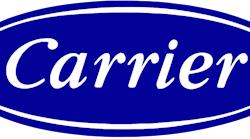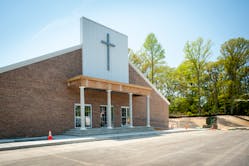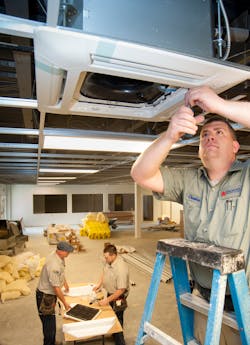In 2014, Faith Bible Church in Mechanicsville, Md., embarked on a major expansion.
“We were hoping to install geothermal units,” Dick Nevala, a church elder who volunteered to serve as project manager, said. “That quickly proved to be cost-prohibitive, but Frank (Simmons, owner of Hollywood, Md.-based Simmons Heating and Air Conditioning Inc.) said he had an idea for a system that would leave us at no disadvantage.”
Systems in Unison
Simmons’ idea was to use high-efficiency heat-pump components to deliver preconditioned makeup air to the facility using variable refrigerant flow (VRF) instead of mini-splits.
“We installed a robust VRF system coupled with a packaged DOAS (dedicated outdoor-air system) to supply all heating, cooling, and ventilation to the huge addition,” Simmons Heating and Air Conditioning installation manager Mike Blaylock said. “The packaged unit is equipped with a large ERV (energy-recovery ventilation) module, an electric heating element, and DX (direct expansion) cooling. Much of the makeup air is supplied through air collars on the VRF ceiling cassettes. In other areas, there’s dedicated ventilation ductwork.”
Simmons worked with sales engineer Ken Herne and product specialist Brian Adkins of Landover, Md.-based Harry Eklof & Associates Inc. to size and select Fujitsu Airstage VRF equipment as well as a Modine Atherion packaged unit for ventilation.
“The original design utilized a large ducted split system that would have occupied much of the mezzanine area,” Adkins, who did much of the VRF design and layout, said. “With our design, the VRF handles all sensible load, while the DOAS supplies all ventilation. The combination cut back the total installed tonnage considerably, and the mezzanine is now office space and an audio loft.”
The 18,500-sq-ft addition, which features a kitchen, a sanctuary, classrooms, and storage space, is more heavily used by the congregation than the original part of the church, built 25 years earlier.
Capability and Flexibility
In October 2014, Simmons began working with the builder, Waldorf, Md.-based Dennis Anderson Construction Corp., to rough in ductwork. As construction progressed, seven Fujitsu Airstage VRF units were installed outside. Near the condensers, a steel frame was erected to support the Atherion unit.
Five 8-ton VRF condensers and two 6-ton condensers are lined up outside of the sanctuary. The units are grouped into three separate systems to serve various portions of the church. Inside, a variety of indoor units were selected to best serve their respective purposes.
Thirty-two Fujitsu ceiling cassettes are used throughout the building. The cassettes serving the kitchen, offices, and storage spaces are equipped with fresh-air collars that provide makeup air from the DOAS.
The sanctuary, lobby, and bathrooms are served by a network of 11 ducted air handlers, while the mezzanine above the sanctuary is served by two 3-ton ceiling-mount units.
Ventilation
Meeting ANSI/ASHRAE Standard 62.1, Ventilation for Acceptable Indoor Air Quality, fresh-air requirements was critical. The Atherion unit provides ERV-tempered exchange air whenever carbon dioxide reaches a certain level. The ERV module is equipped with a zeolite-coated, aluminum energy-recovery wheel, offering lower pressure drop and better heat transfer than comparable designs employing a fabric wheel.
In addition to a ERV module, Atherion contains MERV 13 filtration, a 26-ton DX cooling element, and backup electric heat in a compact, weather-proof cabinet. A hydronic coil or up-to-94-percent-efficient gas furnace is offered in place of an electric strip.
Depending on the outdoor temperature, the ERV module alone may not be enough to bring fresh air to a neutral temperature. In that case, the heating or cooling elements pick up the rest of the load.
“One of the biggest challenges we ran into was getting makeup-air ductwork hung above the sanctuary,” Blaylock said. “The ceiling is 26 ft above a slanted floor. The GC (general contractor) built a mobile ramp to use as a platform for the scissor lift.”
The Atherion unit is mounted on the ground, with a framework underneath to facilitate a down-draft duct configuration.
Making the Jump
“We’ve paired split systems with a DOAS unit like this at other churches, but the size of this project made it worthwhile to look into using VRF for the first time,” Blaylock said. “Selecting the Airstage system was a natural choice because of how happy we’ve been with Fujitsu’s residential line of heat pumps, and the efficiency levels are hard to beat.”
With Airstage, as many as three VRF condensers can be grouped and up to 45 indoor units connected.
“The VRF systems use refrigerant headers instead of branch boxes within the building envelope,” Blaylock said. “The headers offer more flexibility in terms of the number of indoor units that can be connected, and they don’t require a T-stat wire like branch boxes do.”
Airstage components communicate wirelessly, enabling remote monitoring and control.
“The wireless aspect of the installation had a small learning curve, but with training and support from Eklof, it didn’t take long to catch on,” Blaylock said. “The church will monitor their own equipment, but both the Atherion and the VRF systems provide Web access, so we can check on them from the shop.”
Solid Success
“Initially, I was concerned that the units would be noisy, since they’re right outside the sanctuary,” Nevala said. “That’s not at all the case. They’re surprisingly quiet. They just idle along and keep the building comfortable, whether there’s four or 400 people inside.”
The Atherion unit was one of the last pieces of equipment to be installed. It was craned from a truck onto its frame behind the church in late spring 2015. The system was commissioned in mid-July, and the first service was held in the new sanctuary in September.
“Pairing the high-efficiency heat pumps with the packaged unit allowed Simmons to install smaller units,” Nevala said. “That meant a lot, since cost was a big factor. And this past winter, operating expenses were quite a bit lower than we expected. Thanks to Simmons, we’ve been able to shrink both the upfront and continuing costs.”
For Design Solutions author guidelines, call Scott Arnold, executive editor, at 216-931-9980, or write to him at [email protected].












